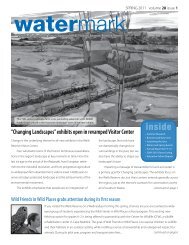Management Plan - National Estuarine Research Reserve System
Management Plan - National Estuarine Research Reserve System
Management Plan - National Estuarine Research Reserve System
Create successful ePaper yourself
Turn your PDF publications into a flip-book with our unique Google optimized e-Paper software.
tions concerning the sustainability of natural andrestored salt marsh habitats in this region. Thesestudies address land-use impacts, nutrient-plantrelations, plant community responses to physicaland hydrologic disturbance, and the relative contributionof short-term natural events (e.g., storms)and human activities (e.g., dredging, tidal restriction)on patterns of sediment accretion and erosion.The <strong>Reserve</strong>’s marshes and beaches are amongthe best-studied sites nationally with regard tolong-term accretion and erosion (over thousands ofyears). The barrier spits that protect these marsheshave also been well studied, especially with respectto alterations due to human activity and sea levelrise.Habitat Value for Fish, Shellfishand BirdsThe <strong>Reserve</strong> combines long-term monitoring withperiodic surveys and short-term experiments toidentify species and measure trends and changes inpopulations of fish, crustaceans, clams, and birds.We have more than 10 years of data on upland birds,wading birds, and shorebirds for assessing populationstatus. Our wading bird data are used as a grossindicator of salt marsh health. Our periodic larval,juvenile, and adult fish surveys have produced thebest available data for fish utilization of salt marshestuaries in the Gulf of Maine. We are currentlyfocused on the development of nekton indicatorsof shoreland land-use impacts on estuarine habitat.We periodically conduct surveys and field experimentsto look at the survival and growth of hatcheryseed, juvenile and adult softshell clams, as well astheir favored habitat characteristics and predationby the invasive green crab. Our food web studiesare quantifying the movement of energy and contaminantsfrom primary producers to nekton.Salt Marsh Degradation andRestorationSince 1991, the Wells <strong>Reserve</strong> has been studying theimpact of tidal restrictions on salt marsh functionsand values, and the response of salt marshes to tidalrestoration. Salt marsh ecosystems in the Gulf ofMaine sustained themselves in the face of sea-levelrise and other natural disturbances for nearly 5,000years. Since colonial times large areas of salt marshhave been lost through diking, draining, and filling.Today, the remaining marshland is fairly wellprotected from outright destruction, but during thepast 100 years, and especially since the 1950’s, saltmarshes have been divided into fragments by roads,causeways, culverts, and tide gates. Tidal flowto most of these fragments is severely restricted,leading to chronic habitat degradation and greatlyreduced access for fish and other marine species.Currently, we are studying how adjacent landuse change is altering the amount and quality offreshwater flow into Gulf of Maine marshes. Underthe umbrella of the Global Programme of ActionCoalition for the Gulf of Maine, and the Gulf ofMaine Council on the Marine Environment, the<strong>Reserve</strong> evaluates monitoring results from marshrestoration projects throughout the Gulf to assesstheir performance and to identify data gaps andfuture monitoring needs.Field <strong>Research</strong> SitesThe Wells <strong>Reserve</strong> supports studies within severallocal estuaries and watersheds. The research programis currently at capacity with respect to itsability to provide on-site staff support to visitinginvestigators, and is approaching capacity for itsrelatively small field site. The <strong>Reserve</strong> encouragesvisiting investigators to consider alternative saltmarsh estuaries for their studies, but does not controlaccess to these sites. <strong>Research</strong>ers using sites outsidethe <strong>Reserve</strong> boundary collaborate with <strong>Reserve</strong>staff but must comply with the research protocols ofthe host location. The Wells <strong>Reserve</strong> would benefitgreatly from an expansion of the coastal area withinwhich its scientists regularly conduct research.Academic and InstitutionalPartnershipsThe Wells <strong>Reserve</strong> maintains professional relationshipswith colleagues at the University ofNew Hampshire, the University of New England,Brown University, Boston University, DartmouthCollege, Antioch New England Graduate School,<strong>Management</strong> <strong>Plan</strong>: <strong>Research</strong> and Monitoring83




